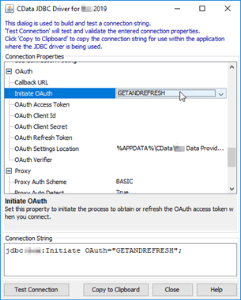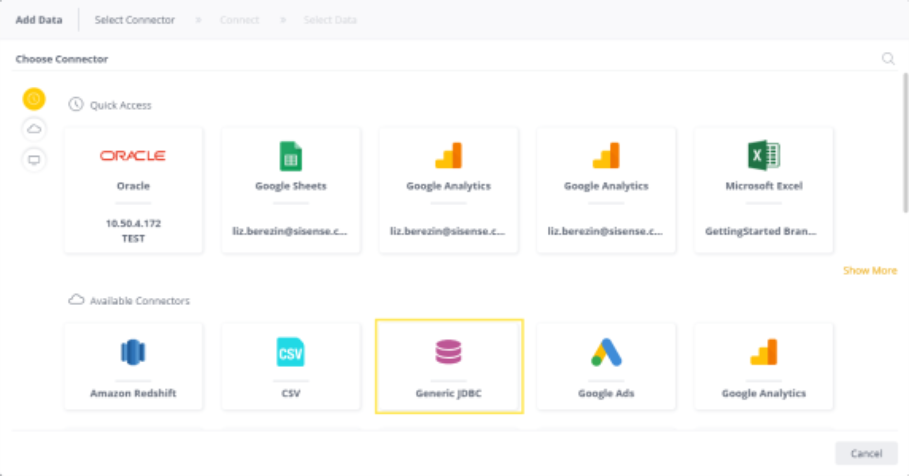Connecting to Facebook
Tier: Launch, Grow, Scale
Offering: Cloud, On-Prem
The Sisense Facebook connector is a certified connector that allows you to import data from the Facebook API into Sisense via theSisense generic JDBC connector. The Facebook connector offers the most natural way to connect to Facebook data, and provides additional powerful features.
The support for the connector is provided by Sisense and will be assisted by the certification partner's support, if needed. For any support issues or additional functionality requests, contact your Sisense representative or open a request through the Sisense Help Center. For advanced inquiries specific to driver functionality, you can also contact the certification partner's support directly via support@cdata.com.
After you have downloaded the driver, you can connect through a connection string. The connection string is used to authenticate users who connect to the Facebook API. Once you have connected to Facebook, you can import a variety of tables from the Facebook.
This page describes how to download the Facebook driver and deploy it, how to connect to Facebook with a connection string, provides information about the Facebook data model, and more.
Note:
For the list of supported connectors, see Data Source Connectors.
Downloading the Facebook JDBC Driver
You can download the Facebook JDBC driver here.
For a short video about downloading the driver, see below (the video uses the Box driver as an example).
Note:
- The driver is certified for Sisense v7.2 and above.
- Sisense v7.4 and above: Click the above link to download a ready-to-use driver.
- Sisense prior to v7.4: Click the above link to download a 30-days free-trial of the driver. Contact Sisense for the full license version.
Deploying the Facebook JDBC Driver
Prerequisite: The install file (setup.jar) is a Java Application that requires Java 6 (J2SE) or above to run.
To install the driver, double-click the setup.jar file and proceed with the instructions in the installation
wizard.
Depending on the machine on which you are accessing the Sisense application, install the driver in one of the
following locations:
- When Sisense is installed on your local machine, deploy the driver locally.
- For a non-local installation (when accessing Sisense on a remote Windows server, or accessing the
Sisense hosted cloud environment), select one of the below methods:
- Deploy the driver on the Sisense server machine, and then perform all the authentication on the server machine.
- Deploy the driver on your local machine (or any other machine, as convenient), perform all the authentication on that machine, and then copy the JAR file to the remote server. For detailed instructions, see Copying a CData JAR File Installed Locally to a Remote Server.
Note:
The default location of the JAR file:C:\Program Files\CData\CData JDBC Driver for <Driver Name> 2019\lib
For a short video of the process, see below (the video uses the Box driver as an example).
JAVA Troubleshooting
If you do not have Java 6 installed, you may download it from here.
If your system is not set up to run Java applications, execute the following command:
java -jar setup.jar
Connecting to Facebook
To access Facebook REST API from Sisense, you must create the connection string to be used in Sisense.
To create the connection string:
-
On the server, create a writable directory (e.g.
/opt/sisense/storage/tmp), and set the connection string parameterLocation=<yourpath>.Tip:
This can be done in the file management UI or by contacting Sisense Support.
- Open the lib directory for the connector. The default path is:
C:\Program Files\CData\CData JDBC Driver for <Driver Name> 2019\lib. -
Double-click the JAR file in the lib directory.

Alternatively, to open the JAR file from the command line, enter the following command in the command prompt (change the driver name to your driver):
cd C:\Program Files\CData\CData JDBC Driver for <Driver Name> 2019\libPress Enter and enter the following command (change the driver name to your driver):
"C:\Program Files\Sisense\infra\jre\bin\java.exe" -jar cdata.jdbc.<Driver Name>.jarPress Enter again.
Example:

The Connection String Builder opens.
-
Click in the Value column of the Initiate OAuth property and select
GETANDREFRESH.
- Click Test Connection. A browser window opens where you need to log in to your application in order to grant access. (Each application will display a different window and messages.)
- Close the Authorization Successful! message that opens.
- Go back to the Connection String Builder dialog and click OK in the Test Connection Successful message to close it.
- Click Copy to Clipboard to obtain the connection string.
For a short video of the process, see below (the video uses the Box driver as an example).
The driver uses embedded credentials that originate from a OAuth App embedded into the driver. The embedded credentials provide full functionality, so you do not have to create an OAuth App.
Note:
If you want to configure the authentication or limit the scope of the data provided to Sisense, you will need to create your own OAuth App. For details, see here.
You need to follow the above instructions only once, to retrieve the Access and Refresh tokens. Once the tokens have been retrieved, the driver will be refreshing them in the background when they expire, with no further involvement from you.
To help you create a connection string and test the connection, see Connection String Builder for Certified Connectors.
If you have any issues connecting to your data source, see Troubleshooting JDBC Data Connectors.
Adding Facebook Tables to your ElastiCube
-
Open Sisense. (For a non-local installation, open Sisense on the hosted cloud environment.)
- In the Data page, open an ElastiCube or create a new ElastiCube.
-
In the Model Editor, click
 . The Add Data dialog box is displayed.
. The Add Data dialog box is displayed.
-
Click Generic JDBC to open the JDBC settings.
_964x542.png)
-
In Connection String, paste the string you obtained above. When you do so, the string is appended with some
_persistproperties.Example:
A sample connection string in Sisense:
jdbc:facebook:Initiate OAuth="GETANDREFRESH";_persist_oauthexpiresin=3109;_persist_token_ - In JDBC JARs Folder, enter the name of the directory where the Facebook JAR file is located (see Deploying the Bing Search JDBC Driver).
- In Driver's Class Name , enter the following class name:
cdata.jdbc.facebook.FacebookDriver - Leave the User Name and Password blank.
- Click Next. A list of tables in the database are displayed. All tables and views associated with the database will appear in a new window.
- From the Tables list, select the relevant table or view you want to work with. You can click next to the relevant table or click Preview to see a preview of the data inside it.
- (Optional) Click + to customize the data you want to import with SQL. See Importing Data with Custom Queries for more information.
- After you have selected all the relevant tables, click Done. The tables are added to your data model.
For a short video of the process, see below (the video uses the Box driver as an example).
Facebook Connector: Additional Resources
For the full documentation set for the Facebook connector, click here.
For connection string options, click here.
For information about the Facebook data model, click here.